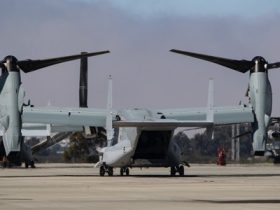The U.S. Army command for the Indo-Pacific finds itself at the front of the service’s transformation initiative, incorporating new unit types created to facilitate rapid adaptation to adversary tactics, according to U.S. Army Pacific Command chief Gen. Charles Flynn.
Several units in the Pacific, from Hawaii to Alaska, were chosen as part of Army Chief of Staff Gen. Randy George’s initiative, dubbed “Transforming in Contact,” Flynn said in an interview ahead of the Association of the U.S. Army’s annual conference.
“But there’s a whole other transformation in contact that’s going on out here at the operational and theater level.”
That transformation has to do with absorbing new organizations and capabilities designed to facilitate the quick incorporation of new tactics and technologies in the field.
“In my view, that is where the connective tissue occurs between tactical forces and operational and strategic forces that exist in the joint world,” Flynn said.
For example, the Army in the Pacific is the first to get a Theater Information Advantage Detachment, Flynn said. The TIAD is meant to keep its finger on the pulse of how adversarial nations like China and Russia are conducting information warfare.
The service has deployed a Security Force Assistance Brigade, a Theater Fires Element and the TIAD into areas near China, Flynn added.
The Army has already created two of three Multidomain Task Forces in the Pacific theater, which have been heavily involved in exercises throughout 2024.
The service is planning to build five MDTFs total. Another is based in Europe, while one more will be based at Fort Liberty, North Carolina, and designed to align with global rapid responses.
The units will operate across all domains — land, air, sea, space and cyberspace — and are equipped with the Army’s growing capabilities, including long-range precision fires.
The MDTFs will take on game-changing capabilities like the Precision Strike Missile, or PrSM, the Mid-Range Capability missile system and the delayed Long-Range Hypersonic Weapon as part of a Long-Range Fires Battalion.
The Army in June fired two PrSM missiles in Palau as part of a ship sinking exercise during Valiant Shield. The service also deployed the MRC missile to the Philippines during the Balikatan exercise in May. The MRC missile system, for the time being, will remain in the Philippines, Flynn said.
The Pacific Army has also established a Theater Strike Effects Group, Flynn added.
“This theater-level Army space formation is integral for today’s battlefield,” Lt. Gen. Daniel Karbler, then the head of Army Space and Missile Defense Command, said in January. “It will allow us to leverage the experience of its command team and staff to ensure success at every echelon, ensuring that all our capabilities are being employed when and where they’re needed best.”
The group will coordinate with the MDTFs that will use Army space interdiction forces with cyber and electronic warfare capabilities to block adversary defenses, according to the Army’s Space and Missile Defense Command.
As it works through the deployment of these major new capabilities like long-range precision fires, it’s imperative, Flynn said, that the Army is organized properly at the theater level in order to effectively coordinate the right engagement authorities.
“This extra capacity at the Theater Army level is transformational and its organizational changes are in front of the arrival of new technologies, new capabilities and new platforms,” he said. “It’s tailored to the region.”
Jen Judson is an award-winning journalist covering land warfare for Defense News. She has also worked for Politico and Inside Defense. She holds a Master of Science degree in journalism from Boston University and a Bachelor of Arts degree from Kenyon College.
Read the full article here








Leave a Reply